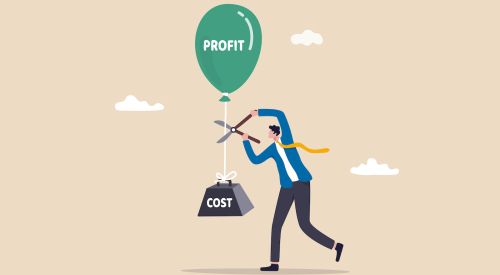With existing home sales down and a surplus of new housing in many parts of the country, home builders are heading back to the days of normal growth and profits. As many of you already know, the industry now has to work harder just to keep sales close to last year's levels.
 One day the market will bounce back. Let's hope you haven't burned your vital resource so you will be poised to seize the day that is destined to arrive again. |
While economists predict that the home building market is going to stay strong for the next 20 years, some home builders have responded to the '06 correction with massive budget cuts and layoffs. However, rather than gut your company and pine for lower interest rates and increased housing demand, home builders should view this slowdown as an opportunity to fix what is wrong in their organizations and maximize their corporation's resources — the people and processes.
I realize the need to cut back in hard times; it's a fact of business. A drop in sales requires cost-cutting measures. However, before you go slashing expenses, it is important to look at every expenditure and its effect on customer satisfaction. It is important not to jeopardize tomorrow's sales by hastily making cuts that could negatively impact the customer experience and choke your referral sales and reputation in the market.
Even cuts that seem to be outside of the customer experience — such as certain layoffs — could affect customer satisfaction.
It is a gamble to make certain cuts so they won't impact the bottom line or customer satisfaction. It's like a mining company betting that a decrease in particular expenditures won't affect employee safety. You have to ask, "Is it really worth the risk?" As miners dig deeper into a shaft, they must shore up the tunnel to make sure it doesn't collapse.
Before you begin heavy cost-cutting, you should implement a quality improvement program to rebuild your processes and become more proficient. That way, you can make the right cuts without gutting your key resources and jeopardizing your future.
Every successful company has natural resources that help set it apart from the competition — the assets you need to protect to remain competitive and ensure that customer service doesn't slip. The ultimate resource is customer satisfaction. Others include your employees, your company culture, process and your brand.
Customer SatisfactionWe all know the power of customer satisfaction when it comes to generating referral business. As the housing market becomes tighter, customer satisfaction will become increasingly important for attracting new business. In an NRS research study, 72 percent of buyers said customer satisfaction awards and recognition were important in their buying decision. Therefore, now is the time to implement programs that bolster customer satisfaction, not cuts that chip away at it.
EmployeesYour internal customers are another key asset you must preserve and occasionally surgically trim. If the decline in new housing sales convinces you to implement a series of layoffs, consider the impact on employee satisfaction and how that could affect customer service. Also, consider the cost of replacing highly qualified and trained employees who jump to the competition because they are no longer part of your organization. Who is going to serve the customer after you pull in the reins? Is it you? Is it your executive team? It's not going to happen, and the end result will be much lower customer referrals. Don't be left without the resources to deliver.
If you lay off, make sure you make up for it with superior management skills. This means:
- Evaluate employees very carefully with a thorough review.
- Weed out those who don't belong.
- Support those who remain by having an action plan to handle the increased workload.
- Provide praise to those who remain and discuss the increased psychological impact these changes have on them.
Remember that your good employees are with you not because of money, but rather because of the companionship, camaraderie and pride they have in their work. Don't gut that too — it comes at no charge to your company.
You treat employees as equals, you value everyone's ideas, you care about their work/life balance, and you even offer free gym memberships to encourage employees to stay healthy. Everything you do says that you care about people, both those who work for you and those who buy from you. It's a way of doing business that has people wanting to do business with you.
But all of this can change if you make the wrong cuts. A culture doesn't emerge overnight, and restoring a culture that's been decimated is an arduous path that takes years of work. So how can you screw this up? Try firing good people in your company who are viewed as valuable. That's a guaranteed way to create turmoil and turn your company culture on its head. Or try stopping your customer loyalty programs and focus completely on the bottom line. Once you've achieved this, everyone else in the company will see this as a signal to stop caring for the customer as well. How about one more horrible recommendation? Lets renegotiate with all our trades and suppliers and mandate they cut their contracts by 15 percent. While you will get many takers, the one who will pay is the customer in the form of reduced quality, understaffed crews and poor quality materials. Not what you asked for.
Now that I have tempered your willingness to fire valuable people in your company, we have less work and lots of good people. What next? Process improvement! This is your company's golden opportunity to ready itself for the next big rush in home building. It is also a time to earn the trust of your employees, trades and suppliers. Make this slowdown the time when you have preserved many resources so you can invest in the future.
Let's demonstrate how your company will preserve many of the people to fix the processes that have been strained for the last five years during the biggest home building rush in history. Much of what we have left today after being trampled by customers is broken systems that need work. This is the time when you can revamp departments, map out your processes, redefine responsibilities, implement measurement systems and ultimately make your company stronger.
Once you've destroyed your brand, it is very difficult to turn it around. We can all think of companies who have been around for decades, only to damage their brands and have to either change their names or sell. For example, Sundance Homes in the Chicago market let its quality get so low during the mid '90s a community protest was mounted against the builder, and in a matter of years, the company was sold and dismantled. Likewise, there are many other stories of builders who forgot about their customer in lieu of the bottom line and have either changed their names or cease to exist.
How about Dell's recent accidental exploding computer. The damage to the brand has been significant, and the next few months and years will determine the actual cost to their company from this failure in quality control. Imagine, for example, a builder who has branded his company as a green builder. In a short-sighted attempt to save money, he does something that is against green building standards to cut costs. As soon as word gets out, the builder's brand would be destroyed. The quickest way to damage your brand is to make cuts that directly impact the work you are known for.
At the end of the day, you have to be making money to survive and flourish. Sound financial planning dictates that expenses be evaluated regularly to ensure the best return on your investments. The same goes for your relationships with employees, suppliers and trades. If cuts are necessary, the challenge is to make them in a way that protects your natural resources and maintains your key company asset: the customer. One day the market will bounce back. Let's hope you haven't burned your vital resource so you will be poised to seize the day that is destined to arrive once again.
| Author Information |
| Paul Cardis is CEO of NRS Corp., a research and consulting firm specializing in customer satisfaction for the home building industry. He can be reached at pacardis@nrs.com. |












